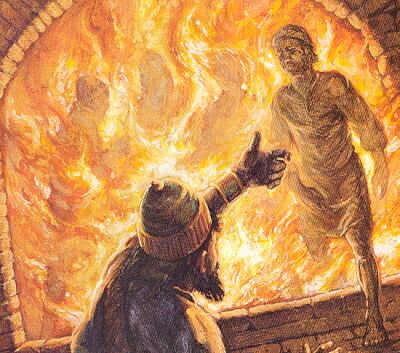This article is part of a series on Old Testament Christophanies. For important background information, see An Introduction to Old Testament Christophanies–with Justin Martyr.

The fourth man appearing in the furnace in Daniel 3 is thought to be the Son of God by many Christians, even by those reading the chapter for the first time. The “man” is never directly called God, Yahweh, or the Angel of Yahweh. Even so, the account is best understood as describing a Christophany.
During the Babylonian exile, King Nebuchadnezzar had a large golden statue made, measuring sixty cubits (ninety-nine feet) high and six cubits (nine feet) wide. The king decreed that when the people heard music playing, they had to fall down and worship the golden statue. Whoever didn’t fall down and worship the statue was to be thrown into a blazing furnace. It was soon brought to Nebuchadnezzar’s attention that Shadrach, Meshach, and Abed-nego refused to worship the statue (vv. 1–12) These three—originally named Hananiah, Mishael, and Azariah respectively—were young Jewish men appointed to serve the king in positions of authority (Dan 1:3–7; 2:49). In Daniel 3:13–23, an enraged Nebuchadnezzar confronted the three men. He asked them, “what god is there who can deliver you out of my hands?” Shadrach, Meshach, and Abed-nego assured Nebuchadnezzar that their God was able to deliver them from the fire and from the king’s hand. And then the three said that even if God didn’t deliver them, “let it be known to you, O king, that we are not going to serve your gods or worship the golden image that you have set up.” Nebuchadnezzar’s face became distorted with rage, and he ordered that the furnace be heated seven times more than normal. Some of the king’s soldiers tied up the three fully clothed men and cast them into the burning furnace. Such a great blaze came from the furnace that the soldiers were killed just by being close to it.
As he looked into the furnace, Nebuchadnezzar suddenly leapt to his feet in amazement by what he saw. The king asked some officials there if only the three men had been thrown into the furnace, and they answered, “Certainly, O king.” (v. 24). But it was more than just three men that Nebuchadnezzar saw:
He said, “Look! I see four men loosed and walking about in the midst of the fire without harm, and the appearance of the fourth is like a son of the gods!” (Dan 3:25).
While the king was surprised by the men walking around in the fire unharmed, he was especially surprised by the fourth man. Some, particularly older translations, such as the Geneva Bible and the King James Version, translate Daniel 3:25 to read, “the son (or ‘Son’) of God.” Later translators argue that the Aramaic elahin is always a plural word, typically rendering it as “sons.” Even though Nebuchadnezzar (a then pagan king) knew about the God of Daniel, it is doubtful he would have understood who the second person of the Godhead was unless it was supernaturally revealed to him. Nebuchadnezzar evidently meant that he saw a godlike or angelic being (Nebuchadnezzar referred to him as an “angel” in verse 28). But regardless of his personal knowledge of who the fourth man was, Nebuchadnezzar’s description was close to the truth. He either saw a created angel sent to save the three or, more likely, he did in fact see the Son of God.
Several patristic writers understood the fourth man in the furnace as the Word, the Son of God. For example, Irenaeus explained that
it is manifest that the Father is indeed invisible . . . But His Word, as He Himself willed it, and for the benefit of those who beheld, did show the Father’s brightness, and explained His purposes . . . at one time He was seen with those who were around Ananias, Azarias, Misael [Hananiah, Azariah, and Mishael], as present with them in the furnace of fire, in the burning, and preserving them from [the effects of] fire: “And the appearance of the fourth,” it is said, “was like to the Son of God.”[1]
And Hippolytus of Rome (ca. 170–ca. 235 AD), one of the most important theologians of his time, went so far as to say that the Word caused Nebuchadnezzar to recognize Him:
Tell me, Nebuchadnezzar, when didst thou see the Son of God, that thou shouldst confess that this is the Son of God? And who pricked thy heart, that thou shouldst utter such a word? And with what eyes wert thou able to look into this light? And why was this manifested to thee alone, and to none of the satraps about thee? But, as it is written, “The heart of a king is in the hand of God:” [Prov 21:1] the hand of God is here, whereby the Word pricked his heart, so that he might recognise Him in the furnace, and glorify Him. And this idea of ours is not without good ground. For as the children of Israel were destined to see God in the world, and yet not to believe on Him, the Scripture showed beforehand that the Gentiles would recognise Him incarnate, whom, while not incarnate, Nebuchadnezzar saw and recognised of old in the furnace, and acknowledged to be the Son of God. “And he said, Shadrach, Meshach, and Abednego.” The three youths he thus called by name. But he found no name by which to call the fourth. For He was not yet that Jesus born of the virgin.[2]
Continuing in Daniel 3, Nebuchadnezzar called the three men out of the fire, recognizing them as servants of the “Most High God.” The various officials there examined the three and found that the fire had no effect on them or their clothes, nor did they smell like smoke (vv. 26–27). If the fourth man was the Son of God, then the men’s ability to walk around in the fire unburned is easily understood. We may then say that the Son created a cocoon of Shekinah glory around Himself and the three men—the fire of the Lord’s glory preserving them within the burning flames. The natural fire was either allowed to burn away their bindings or the fourth man removed them.
Nebuchadnezzar responded to what he had witnessed by saying, “Blessed be the God of Shadrach, Meshach and Abed-nego, who has sent His angel and delivered His servants who put their trust in Him, violating the king’s command, and yielded up their bodies so as not to serve or worship any god except their own God.” Nebuchadnezzar then decreed that anyone who spoke against the God of Shadrach, Meshach, and Abed-nego would be dismembered and his house would be razed, because “there is no other god who is able to deliver in this way.” Then the king promoted the three to higher positions in the province of Babylon (vv. 28–30).
The “angel” Nebuchadnezzar saw was probably the Angel of Yahweh. He rescued God’s people by appearing in a fire that didn’t consume the three men. The Angel of Yahweh had famously appeared to Moses in a blazing fire from the midst of a bush, yet the bush wasn’t consumed (Exod 3:2–3). And coming to save God’s people is something we would expect from the Angel of Yahweh. It is in the Savior’s character to save.
[1] Irenaeus, Against Heresies 4.20.11.
[2] Hippolytus, Extant Works and Fragments: On Daniel 3.92–93 (i.e., 25–26)., in The Ante-Nicene Fathers, vol. 5.

Leave a Reply